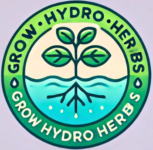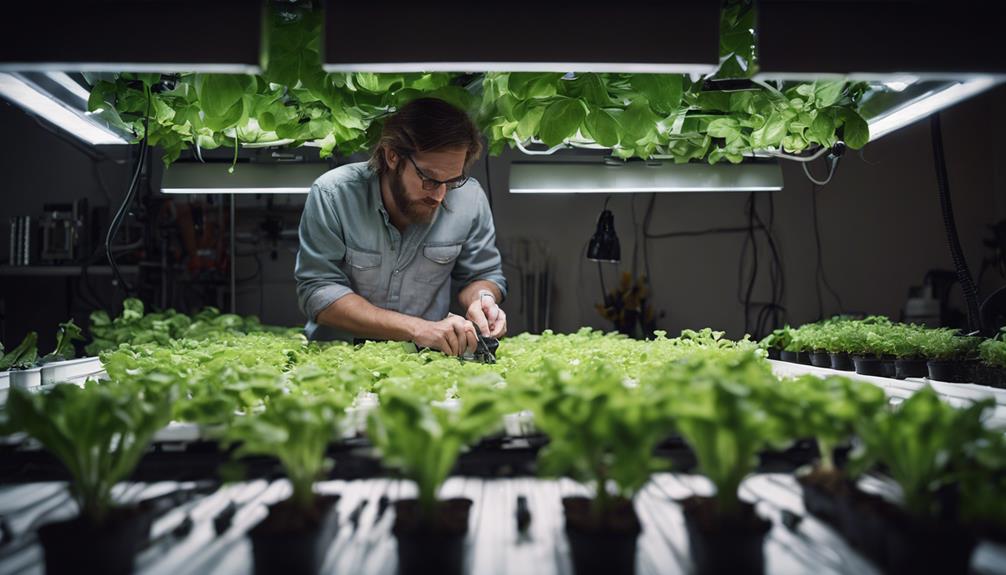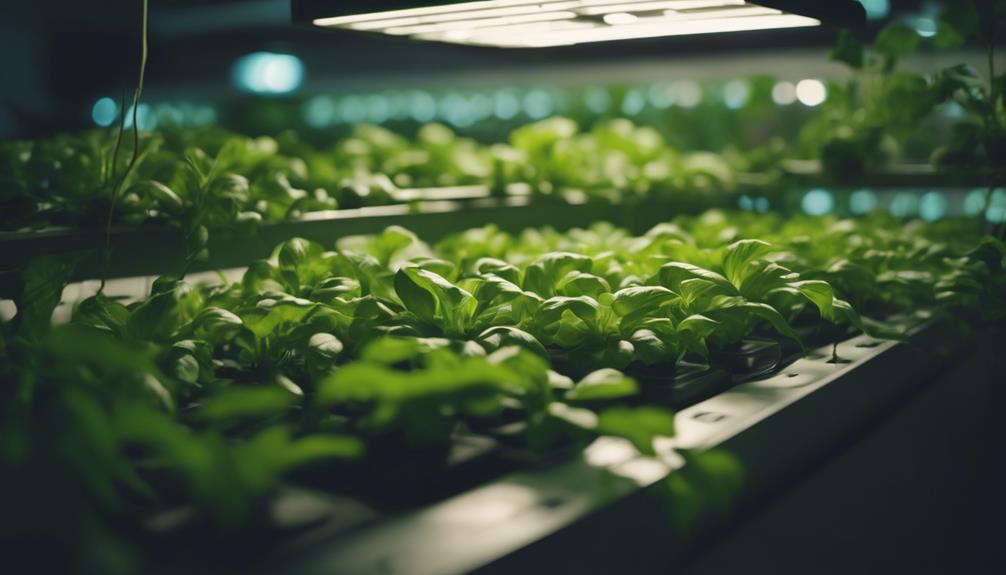Why Consider Different Types of Grow Lights for Indoor Hydroponics Gardening?
When it comes to indoor hydroponic gardening, grow lights are essential. Without natural sunlight, they provide the specific light spectrum plants need to grow and thrive. Whether you’re cultivating herbs, vegetables, or flowers, these lights are crucial for successful growth.
There are three main types of grow lights you’ll encounter in hydroponic grow lights: LED, HID, and Fluorescent. Each comes with its own set of benefits, making them suitable for different needs and garden setups. Understanding each type will help you choose the best one for your hydroponic herb garden.
Choosing the right grow light goes beyond just giving your plants light. It affects their growth rate, overall health, and the yield you can expect. For herbs, especially, the correct lighting can improve flavor, aroma, and potency. These lights mimic the natural sunlight your plants need, ensuring you grow flavorful, healthy herbs indoors.
Before we dive into the specifics of each grow light, let’s first understand why they’re so critical in a hydroponic system. Hydroponics relies on nutrient-rich water instead of soil. Without natural sunlight, grow lights fill that gap, giving your plants the energy they need to grow. With the right setup, you can enjoy fresh, homegrown herbs all year long.
GrowHydroHerbs TLDR
- LED grow lights are energy-efficient, long-lasting, and customizable for different plant stages.
- HID grow lights offer powerful lighting but require more energy and cooling systems.
- Fluorescent grow lights are affordable and ideal for beginners with smaller gardens.
- Each light type suits different gardening needs—consider space, budget, and heat management when choosing.
As you set up your indoor garden, keep in mind your space, budget, and the types of herbs you’re growing. Each factor will influence which type of grow light is best for your setup. In the following sections, we’ll break down LED, HID, and Fluorescent grow lights, helping you make an informed decision.
LED Grow Lights: Energy-Efficient and Long-Lasting

LED grow lights are increasingly popular, and for good reason. They offer excellent energy efficiency and long life, making them perfect for serious hydroponic gardeners.
One of the biggest advantages of LEDs is their low energy use. Compared to traditional grow lights, LEDs consume far less electricity. Over time, this can lead to significant savings on your energy bills. Plus, their long lifespan—ranging from 50,000 to 100,000 hours—means less frequent replacements and lower maintenance costs.
LEDs also stand out for their customizable light spectrum. They can be adjusted to emit specific wavelengths of light that benefit plant growth at different stages. Full-spectrum LED lights, which mimic natural sunlight, are especially useful for growing herbs indoors.
For those serious about hydroponic gardening, popular options include the Spider Farmer SF series and the Mars Hydro TS series. These lights are known for their performance, reliability, and value for money.
In short, LED grow lights provide energy efficiency, long-lasting durability, and a customizable light spectrum that makes them an excellent choice for any hydroponic herb garden.
HID Grow Lights: Power for Larger Setups

HID (High-Intensity Discharge) grow lights are known for their powerful light output, making them ideal for larger gardens or more demanding setups. They come in two types: Metal Halide (MH) and High-Pressure Sodium (HPS), each serving a specific purpose in plant growth.
Metal Halide (MH) lights work best during the vegetative stage, producing bright, cool light that encourages leafy growth and strong stems. This makes them a good choice for herbs in their early growth stages.
High-Pressure Sodium (HPS) lights, on the other hand, excel during the flowering and fruiting stages. They emit a warm, red-orange light that stimulates blooming and fruit production, perfect for when you want to maximize yields.
While HID lights are powerful, they do have drawbacks. They consume more energy than LEDs or fluorescent lights and produce a lot of heat, which may require additional cooling systems. These lights are best for larger setups, where their intensity can be fully utilized without overheating your plants.
In conclusion, HID lights offer powerful lighting, but you’ll need to manage the extra heat and energy consumption. They work best in larger spaces with proper ventilation and cooling systems.
Fluorescent Grow Lights: Affordable for Beginners

Fluorescent grow lights provide a budget-friendly option for those just starting out in indoor hydroponics. They come in a few varieties, including T5, T8, and compact fluorescent lamps (CFLs).
T5 lights are the most efficient, providing high output while fitting easily into small spaces. They’re perfect for seedlings and young plants.
T8 bulbs are slightly less efficient but still effective. They’re often used in larger setups where multiple bulbs are needed to cover a bigger area. Their lower cost makes them accessible to beginners.
Compact fluorescent lamps (CFLs) are small, versatile, and can be used for both vegetative and flowering stages. They’re a good option for gardeners with limited space or for those looking to supplement natural light.
Fluorescent lights are known for their affordability and lower energy consumption compared to HID lights. Most fluorescent grow lights offer a full-spectrum, making them suitable for various stages of plant growth.
In short, fluorescent grow lights are an affordable, easy-to-use option for beginners. They’re perfect for smaller spaces and won’t break the bank.
Comparing LED, HID, and Fluorescent Grow Lights

When choosing the right grow light, several factors come into play: energy efficiency, lifespan, heat production, light spectrum, and cost. Here’s a quick breakdown of how LED, HID, and Fluorescent lights compare:
- Energy Efficiency: LEDs are the most energy-efficient, followed by Fluorescent lights. HID lights use the most power.
- Lifespan: LEDs last the longest, up to 100,000 hours. Fluorescents have a moderate lifespan, while HID lights need frequent replacements.
- Heat Production: LEDs produce the least heat, Fluorescents moderate heat, and HID lights the most.
- Light Spectrum: LEDs offer customizable light spectrums. Fluorescent lights provide balanced, full-spectrum light. HID lights require switching between MH for vegetative growth and HPS for flowering.
- Cost: LEDs have a higher upfront cost but save money over time. Fluorescent lights are the most budget-friendly option, while HID lights can become costly due to energy use and maintenance.
By considering these factors and understanding the unique needs of your hydroponic garden, you can choose the best light for your setup.
Practical Tips for Choosing the Right Grow Light
To make the best choice for your hydroponic herb garden, consider the following tips:
- Assess the specific light needs of your herbs. Some herbs, like basil, need more intense light, while others, like parsley, can thrive with moderate lighting.
- Budget matters. Fluorescent lights are a great option for beginners, while LEDs, though more expensive initially, provide long-term savings.
- Consider the size of your garden. HID lights are ideal for larger setups, while LEDs and Fluorescents work well in smaller spaces.
- Keep operational costs in mind. While HID lights offer powerful output, they can drive up energy bills. LEDs, on the other hand, are energy-efficient and have a longer lifespan.
- Don’t forget about heat management. If you want to avoid installing cooling systems, go for LEDs, which produce the least heat.
By matching the right grow light to your needs, you’ll create an ideal environment for your herbs to flourish.
Types of Grow Lights: Making an Informed Decision
After exploring LED, HID, and Fluorescent grow lights, the key to a successful hydroponic herb garden is selecting the right light for your situation. Each type has its advantages and drawbacks, and choosing the one that suits your space, budget, and plant needs will help ensure your garden thrives.
LED grow lights stand out for their energy efficiency and long lifespan. HID lights, while powerful, require more maintenance and cooling. Fluorescent lights offer a simple, budget-friendly option for beginners or smaller spaces.
By carefully considering your gardening goals and the specific needs of your herbs, you’ll be well-equipped to choose the perfect grow light for a lush, productive garden.
Frequently Asked Questions
What are the main types of grow lights for hydroponic gardening?
The main types are LED, HID, and Fluorescent grow lights. Each of these offer different benefits for indoor gardening.
Are LED grow lights good for herbs?
Yes, LED grow lights are energy-efficient and customizable. They are ideal for growing herbs at different stages of growth.
What’s the difference between HID and Fluorescent grow lights?
HID lights are powerful and suited for larger spaces. On the other hand, Fluorescent lights are affordable. They are perfect for beginners, and generate less heat.
Which grow light uses the least energy?
LED grow lights use the least energy. This makes them the most efficient option for long-term indoor gardening.
Can I use fluorescent grow lights for a small herb garden?
Yes, Fluorescent grow lights are great for small spaces and beginner setups, providing sufficient light at a low cost
How do I choose the best grow light for my hydroponic herbs?
Consider your space, budget, energy use, and the types of herbs you’re growing to select the right grow light for your needs.


